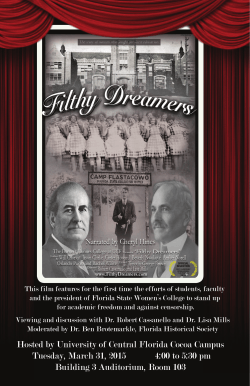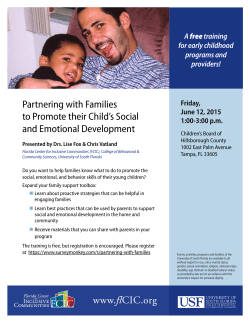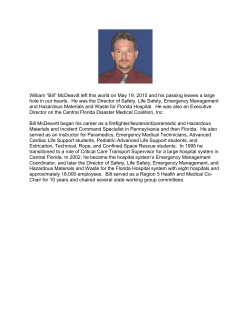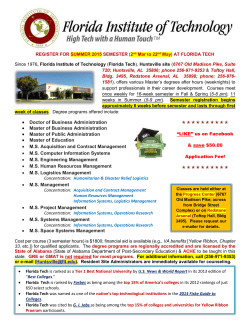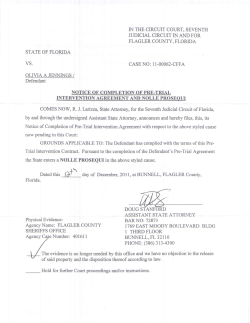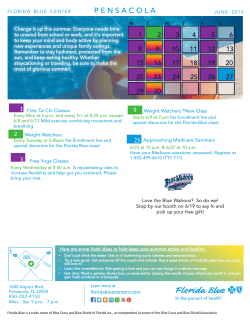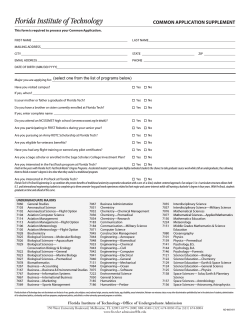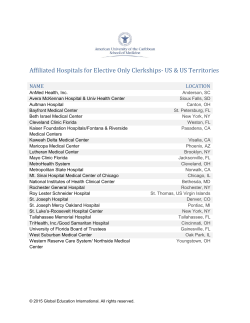
Beating Cancer from the Inside Out Beating Cancer from the Inside Out
VOL. 12, ISSUE 1 Focusing on the Discoveries and Innovations Faculty and Students Are Making at Beating Cancer from the Inside Out Making More Lanes on the Information Superhighway—page 4 Why Wearable Computers Will Change the Way We Work—page 14 Coral Reefs and the Impact of Global Warming—page 16 M E S S AG E F R O M T H E P R E S I D E N T AND CHIEF EXECUTIVE OFFICER Humankind progresses by discovering the new and building upon the known. Both of these processes are at the heart of our mission here at Florida Tech, and the variety, depth and scholarship our faculty and students put into them are on brilliant display in the 2015 edition of our research magazine, Discovery. As you’ll see in the wonderful photos and compelling articles that follow, our scientists and researchers are tackling some of society’s biggest challenges: cancer and Alzheimer’s disease, global warming, space, our digital world and more. It is a mix of nature and technology, of seascapes and outer space, of age-old ailments and challenges that could only arise in the modern era. Together, these myriad issues reflect the amazing variety of learning taking place within our classrooms and laboratories. So we are both discovering the new and building upon the known here at Florida Tech, and I am delighted that with Discovery, you will experience and understand this for yourself, as well. Sincerely yours, A.J. Catanese, Ph.D., FAICP President & Chief Executive Officer DISCOVERY http://discovery.fit.edu Florida Institute of Technology PRESIDENT AND CHIEF EXECUTIVE OFFICER Anthony James Catanese, Ph.D., FAICP EXECUTIVE VICE PRESIDENT AND CHIEF OPERATING OFFICER T. Dwayne McCay, Ph.D. VICE PRESIDENT FOR RESEARCH Frank Kinney VICE PRESIDENT FOR MARKETING AND COMMUNICATIONS Wes Sumner DISCOVERY is published once a year by Florida Tech’s Office of Marketing and Communications and is distributed to over 50,000 readers. EDITOR Adam Lowenstein, adam@fit.edu ART DIRECTOR Judi Tintera, jtintera@fit.edu ASSISTANT EDITOR Christena Callahan, ccallaha@fit.edu CONTRIBUTING WRITERS Ashley Carnifax, Adam Lowenstein PRODUCTION Kristie Kwong WEB LAYOUT Joshua Culver PHOTOGRAPHY Dominic Agostini M E S S AG E F R O M T H E E X E C U T I V E VICE PRESIDENT AND CHIEF O P E R AT I N G O F F I C E R There is no substitute for learning by doing. In my years in academia, and in my decades as an engineer and research scientist, I found that always to be the case. It certainly remains so today. The research and discovery carried out in the classrooms and laboratories of Florida Tech—and brought to compelling life in the magazine you now hold in your hands—may be guided by our world-renowned faculty members, but the success and achievements laid forth here would often not be possible without the involvement of our students. From undergraduates through our master’s and doctoral candidates, students play a key role in our research here. Whether working in a lab or kayaking along the Indian River Lagoon, operating an unmanned aerial vehicle or monitoring vital signs during a clinical test, our students definitely learn by doing. That’s because Florid Tech understands the importance of taking learning beyond the classroom. After reading Discovery, I think you will, too. Respectfully, T. Dwayne McCay, Ph.D. Executive Vice President & Chief Operating Officer HOW TO KEEP IN TOUCH Florida Tech, Office of Marketing and Communications, 150 W. University Blvd., Melbourne, FL 32901-6975, 321-674-8548, Fax 321-674-8598, wsumner@fit.edu CHANGING ADDRESSES? Don’t leave copies of your Discovery magazine behind. Send your new address to Florida Tech, Office of Development Services, 150 W. University Blvd., Melbourne, FL 32901-6975, advs@fit.edu www.fit.edu © Copyright 2015 by Florida Institute of Technology. All rights reserved. Reproduction by any means whole or in part without permission is prohibited. For reprint information, contact Discovery at 321-674-8963, Fax 321-674-8598 or jtintera@fit.edu. Cover Photo: Michael Fenn, assistant professor of biomedical engineering at Florida Institute of Technology, with the university’s custom-made Renishaw Raman micro-spectrometer, an essential tool for his cancer research. Florida Institute of Technology is accredited by the Southern Association of Colleges and Schools Commission on Colleges to award associate, baccalaureate, master’s, education specialist and doctoral degrees. Contact the Commission on Colleges at 1866 Southern Lane, Decatur, Georgia 30033-4097 or call 404-679-4500 for questions about the accreditation of Florida Institute of Technology. Florida Institute of Technology does not discriminate on the basis of race, gender, color, religion, creed, national origin, ancestry, marital status, age, disability, sexual orientation, protected veterans status or any other discrimination prohibited by law in the admission of students, administration of its educational policies, scholarship and loan programs, employment policies, and athletic or other university sponsored programs or activities. 2 DISCOVERY: FLORIDA TECH 6 Minor Takes Off Unmanned Aerial Systems program offers skills for aviation to come. Some of the vehicles and equipment used with Florida Tech’s newest aviation minor. SPRING 2015 ISSUE 4 Optimizing Fiber Optics As devices, streaming content and applications gobble up more and more digital bandwidth, Syed Murshid has a way to eliminate slowdowns. 6 Up in the Sky, Down on the Ground 18-credit-hour minor among growing academic focus on pilotless aerial vehicles. 8 Search and Destroy Michael Fenn is developing ways to use nanoparticles to detect cancer—and then stop it. 11 A Murky Existence, in the Water and Out Scientists, conservationists and researchers are teaming up to better understand, and protect, the Florida east coast diamondback terrapin. 14 Head’s Up Wearable computers like Google Glass could reshape our relationship to technology. Florida Tech, NASA and other partners are exploring what this could mean in the workplace. 16 Coral Reefs and Warming Oceans Two studies involving coral have helped us understand climate change’s impact, and also how to survive it. 18 A Deeper Understanding of Concussions NSF-funded research at Florida Tech may shed light on one major effect of these serious head impacts. 20 The View from Above From growing protein fibers on the International Space Station to studying the sun’s interaction with the far reaches of our solar system, Florida Tech faculty continue to strengthen the university’s heritage as a leader in astronomical research. 22 Research in Brief Safer aviation, harnessing the power of waves and an assignment from Homeland Security are among the ongoing research projects at Florida Tech. View past issues of Discovery at: http://newsroom.fit.edu/discovery W E ’ R E L I S T E N I N G . Please send any comments or suggestions to Adam Lowenstein, adam@fit.edu DISCOVERY: FLORIDA TECH 3 Optimizing Fiber Optics If you have siblings or roommates, you probably know the telltale signs of reaching the bandwidth limits on your Internet connection: online gaming lags, streaming video won’t load, frustration rises. Total Internet traffic is increasingly globally, so slowdowns like this are afflicting apartments, houses and offices from Melbourne, Florida, to Mumbai to Milan. In fact, if traffic continues to increase at the pace it is rising now, we can expect to see a 10,000-fold increase in data traffic in the next 20 years, according to Syed Murshid, a professor in the department of electrical and computer engineering at Florida Tech. But Murshid isn’t just monitoring that growth. He and his team of graduate students are responding of tearing into walls to remove the old ones is just too much. This is a wasteful process that to it with research and products that leaves a large amount of installed could drastically reduce, or even fibers unused. So Murshid and his eliminate, these irritating slowdowns. team developed something called Because even with the Spatial Domain Multiplexing that fastest mode of data transfer would allow these older fibers, as available—fiber optics—the current well as the new ones, to continue infrastructure cannot support to be utilized as the demand for this kind of data increase. As the high-speed Internet increases. technology develops and demand Spatial Domain Multiplexing, or rises, many buildings, including SDM, is a method within fiber optics critical centers such as the Pentagon, that allows many channels of light to are simply laying higher-speed go through a fiber and, in the part of fibers down because the cost the process that earned Murshid and 4 DISCOVERY: FLORIDA TECH Sending data in two directions— clockwise and counterclockwise— allows it to exist in the same circle at the same time, Florida Tech Professor Syed Murshid found. This orbital angular momentum allows for more data transmissions. “As this technology continues to mature, we expect to see many benefits, such as improved signal strength, increased capacity and heightened digital capabilities in the business world.” Syed Murshid | Professor — Electrical and Computer Engineering Professor Syed Murshid, seated, works with his graduate student, Saud Alanzi, on an experimental demonstration involving his ground-breaking work in fiber optics. his team a U.S. patent, be separated at benefits, such as improved signal in the same circle at the same time, the end. The channels are separated strength, increased capacity and which further doubles the amount in a way that allows the capacity of heightened digital capabilities in of data that can be transmitted. current optical fibers to be multiplied. the business world,” Murshid said. The multiplexer device connects As if that wasn’t enough of All told, Murshid’s invention, when implemented, could initially to the start and end of fibers and a discovery, Murshid also proved speed up existing Internet by allows data to pass through in a the existence of something called tenfold, and even more in the series of concentric circles, rather orbital angular momentum in future, meaning your next movie than just one stream of data at a time, fiber optics. By sending some data night and your roommate’s gaming increasing the data rate by five times streams in a clockwise motion marathon could peacefully coexist. what unmodified fibers can do. and others in a counterclockwise “As this technology continues to mature, we expect to see many motion, he has been able to show Ashley Carnifax that these two sets of data can exist DISCOVERY: FLORIDA TECH 5 Up in the Sky, Down on the Ground Though unmanned aerial vehicles are, as the name suggests, lacking onboard taking newpilots, photo these aircraft do not fly themselves. But operating UAVs, which can range from lightweight quadcopters to Global Hawks weighing 15,000 pounds, is not like operating a remote-controlled helicopter from the hobby shop. Flying is part of the necessary skill set, to be sure, but so, too, is building, programming and modifying the vehicles—even planning missions. All of those areas are taught The World Unmanned Aerial searches. Another will investigate in the Unmanned Aerial Systems Vehicle Systems, Market Profile the efficacy of “geofencing” at program at Florida Tech, an and Forecast 2014 from Teal Group airports, a technique that creates a 18-credit-hour minor that positions estimates that UAV spending GPS barrier meant to prevent UASs the Melbourne-based university worldwide will nearly double over from entering particular airspace. among a handful of schools the next decade, from $6.4 billion that understands the future of annually to $11.5 billion, with nearly even yet to be discovered, and aviation, aeronautics and many $91 billion spent over that time. the technology is only going to other fields will involve unpiloted Even before the launch of the “There are so many applications improve,” Moore said. “People aerial vehicles—and people minor program in fall 2014, Florida haven’t really cracked the code skilled in the ways to use them. Tech faculty have been exploring on the best practices for different the potential uses of unmanned applications—what the challenges the students to be, because aerial systems. For example, College are, how to mitigate risk—and they are getting into an industry of Engineering faculty members L. we’re excited about exploring these on the ground floor,” said Julie Daniel Otero and Paul Cosentino areas and leading the way in this Moore, a major in the U.S. Air received a $250,000 grant from the important research and discovery.” Force and assistant professor of Florida Department of Transportation aviation science at Florida Tech’s to research the use of UAVs in College of Aeronautics, who is inspecting bridges leading the UAS minor program. and tall lights, called “It’s an exciting place for And already that ground floor is crowded: scientific research, high mast luminaries. And Moore’s infrastructure inspection, firefighting, students in the UAS agricultural monitoring, law minor are pursuing enforcement—all current or other areas as team potential uses for unmanned aerial projects. One will use vehicles. There are geophysicists who an unmanned aerial use them to predict the location of system to simulate mineral deposits and NOAA scientists search and rescue who hunt hurricanes with UAVs. efforts to determine And the list will only grow. how that method compares with on-foot 6 DISCOVERY: FLORIDA TECH Adam Lowenstein Leading the UAS minor program is Julie Moore, a major in the U.S. Air Force and assistant professor of aviation science at Florida Tech’s College of Aeronautics. “It’s an exciting place for the students to be, because they are getting into an industry on the ground floor.” —Julie Moore | Assistant Professor of Aviation Science Unmanned Aerial Systems lab assistant Dennis Dalli flies an unmanned aerial vehicle at the Center for Aeronautics and Innovation lab at Florida Tech. Through the goggles, he can see the UAV’s camera feed. DISCOVERY: FLORIDA TECH 7 Michael Fenn, right, assistant professor of biomedical engineering at Florida Tech, in the lab with Gengbo Liu. Fenn and his students are working on cuttingedge methods of cancer detection and therapy. Search and Destroy The relentlessness of cancer is renowned, and terrifying. In 2015, more than 1.6 million new cases of cancer are expected to be diagnosed in the U.S., according to the American Cancer Society. And with nearly 590,000 Americans expected to die of cancer this year, the disease remains the second most common cause of death in America, accounting for nearly one of every four deaths. Put another way, most the most deadly type of brain tumor. honest manner, ‘Well, Mike, we of us have had cancer touch At the time recently graduated try our best with all of this fancy our lives in some way. with his undergraduate degree in equipment, but it’s really still not chemistry and biochemistry, he much more than an educated guess.’” That includes Michael Fenn, That sparked Fenn’s fascination one of several faculty members at asked this question: How could the Florida Tech who are focused on surgeon differentiate the normal with cancer research, and better ways to understand, detect tissue from the tumor tissue? particularly with cancer detection. and, someday, defeat cancer. “This silenced the normally Now, as an assistant professor of bustling operating room, and his biomedical engineering at Florida seven years ago, in an operating room, reply was something I will never Tech and associate director of the as he observed a surgeon working on forget,” Fenn recalled. “He said, university’s Center for Medical a tangerine-sized glioblastoma tumor, in a very calm, yet very frank and Materials and Photonics, one of the Fenn had his moment about 8 DISCOVERY: FLORIDA TECH major objectives of his research is gold nanoparticles—also developed to the cancer cells in a specific developing ways to both diagnose in his lab—to greatly increase the patient in tandem with Raman and treat cancers simultaneously, Raman signal intensity and thus spectroscopy to detect and help in real time. The hope is that these produce a significantly higher determine the course of treatment advances will enable doctors to do sensitivity and specificity. for cancer patients, would be a microscopic exams of living tissue These nanoparticles are amazing major breakthrough and is one of inside the body during surgery in their own right: They can be made and will help the accuracy of the to release a therapeutic payload via diagnostic process in general. an optical drug delivery mechanism STUDYING GROWTH or be used for photothermal Julia Grimwade and Alan Leonard Others at Florida Tech, including Julia therapy, while simultaneously have spent the past 25 years studying Grimwade and Alan Leonard, and yielding real-time monitoring of cell growth and division processes Kunal Mitra, are bringing their own the biochemical environment academic and scientific expertise through continuous collection of that are critical to understanding continued on page 10 to cancer-related challenges. data from the Raman system. Fenn is not alone in his quest. the primary goals in Fenn’s lab. This technique, Fenn said, has A CATALYST Fenn himself was surprised — the potential for use as a highresolution, extremely sensitive in-situ shocked, he said—by the surgeon’s histopathology platform; that is, answer to his question. “This it could be used to perform tissue moment, ingrained in my brain analysis during surgical procedures, almost as much as that of the patient and thus be able to demarcate tumor in the operating room that morning, borders from normal tissue and became my catalyst that sent me differentiate cancer subtypes with a back to school in search of a better high degree of specificity in real time. way to detect and diagnose cancer.” No longer would that surgeon Fenn began working for a Fenn worked with years ago have research group at the University of to make an educated guess about Florida Particle Engineering Research cancer tissue and normal tissue. Center helping to develop novel “Such analysis capabilities nanoparticles that could provide a afforded by the nanoprobes, and variety of imaging capabilities and the ability to simultaneously then highly specific cancer cell targeting, deliver treatment via optically as well as simultaneous delivery activated drug release or heating of therapy. In other words, finding of the nanoparticles by a laser the cancer and then treating it. light source, would dramatically That work has continued at enhance the way we detect Florida Tech, where Fenn is using a and treat cancer,” Fenn said. custom-made Raman spectroscopic Furthermore, doing so on imaging system and Surface- a personalized level, by using Enhanced Raman Spectroscopy antibodies attached to these (SERS), which utilizes cell-targeted nanoprobes that are specific (top) This map shows a Raman/SERS spectral map overlaid on a fluorescence image of NIH3T3 fibroblast cells on a tissue engineering PCL polymer mesh treated with nanostars. (bottom) A 3-D Raman spectral map of NIH3T3 fibroblast cells with overlay of fluorescence image. DISCOVERY: FLORIDA TECH 9 Alan Leonard and Julia Grimwade Kunal Mitra continued from page 9 and, therefore, treating and even these mutations to characterize preventing diseases such as the stages of initiation—the “Optical Tomography System using cancer and bacterial infections. process in which cells begin Short Pulse Laser for Early Cancer division—and to understand the Diagnostics,” which uses a short- themselves in order to reproduce, role of specific proteins in this pulse laser to transmit optical signals and normally that’s a really tightly process. But as they’ve done these toward various tissue, which can then controlled process,” Grimwade, manipulations, they’ve found be reconstructed into 3-D images. professor and chair, Premedical that other proteins are changing Biology Program in the department their behaviors to compensate. “All cells have to duplicate of biological sciences, said. Their more recent findings He holds a patent for an This noninvasive, quick procedure is ideal for early diagnosis of cancer. “When it isn’t tightly controlled have confirmed that even in the in humans, we get things like simplest of systems, the beginning research is using this system to cancer. In bacterial systems, if it of chromosome replication is a detect cancer at early stages and isn’t controlled and they infect us, very complicated process and is then irradiate the tumor without then we get infectious diseases.” one best studied by asking simple causing thermal damage to By determining the key questions and letting the answers surrounding healthy tissues, which lead to the next set of experiments. occurs during such treatment,” Mitra stages in the DNA separation “One of the goals of this said. “This will be like a combined process, Grimwade and Leonard, a professor of biological sciences, LASER FOCUS system which is challenging to are working to develop ways to Kunal Mitra, a biomedical build but unique in the field of inhibit cell duplication, which engineering professor at Florida cancer detection and treatment.” could prevent the growth and Tech, focuses on the intersection Mitra and his team have spread of a number of diseases. between lasers and optics and had great results using these biomedical engineering. He technologies on animal models Leonard developed an easy started by developing models for in the lab and hope to license it method for placing mutations into studying the way lasers interact and develop a prototype system DNA, simplifying the way they with tissues. He said once he to use as a screening system looked at possible protein-DNA started looking for applications for for skin cancer detection. reactions. Recently, they have used this technology, cancer detection In 2012, Grimwade and 10 DISCOVERY: FLORIDA TECH seemed like an obvious choice. Adam Lowenstein and Ashley Carnifax A Murky Existence, in the Water and Out Florida Tech, DEP, Brevard Zoo Join Forces to Better Understand Little-Known Turtle “Pure turtle soup containing only genuine turtle meats,” read one ad from the 1930s. “Special Homemade Snapper Soup 25¢,” read another. A century ago, turtle meat was more common in our kitchens. Often in soups, but found in a variety of dishes, turtle meat was a culinary trend that did more than get food on the table. It also brought the diamondback terrapin to the edge of extinction. Marc Virgilio, formerly with the Florida Department of Environmental Protection’s Indian River Lagoon Aquatic Preserves program, holds a female diamondback terrapin. DISCOVERY: FLORIDA TECH 11 The only turtle whose exclusive The quest to fill in those habitat is the brackish region of the gaps and better understand the Atlantic coast from Texas through key role these critters play in the Florida and into the grass flats north Indian River Lagoon ecosystem to Massachusetts, the diamondback led three powerful forces to unite: terrapin had the unfortunate Florida Tech, the Brevard Zoo distinction of being among the and the Florida Department of most popular of the edible turtles. Environmental Protection (DEP). At its peak, the meat from Marc Virgilio, a former Malaclemys terrapin tequesta environmental specialist with was worth more than gold. In DEP’s Indian River Lagoon Aquatic addition to domestic consumption, Preserves program, and Amy these animals were also Reaume, the zoo’s conservation exported in huge numbers to coordinator—both Florida Tech Europe for the food market. alumni, coincidentally—were joined Since then, scientists, by Grace and his students on kayak conservationists and researchers expeditions among the Thousand have worked to develop a better Islands, even as Virgilio and Reaume understanding of the seven undertake efforts more specifically subspecies of the diamondback tied to their respective organizations. terrapin. However, like the murky They are among a host of water these reptiles call home, community and state partners who one subspecies remains largely a have conducted field surveys and mystery. It is the east-central Florida other research for the last several resident known as the Florida east years to further our understanding coast diamondback terrapin. of these small critters. “Efforts to save the species “There is a complete lack of data,” have led to studies in a variety of said Reaume, who helped involve the areas, but our own subspecies here community in monitoring Brevard in east-central Florida is probably County’s terrapins by spearheading the most poorly understood of community reporting initiatives. any,” said Michael Grace, associate “The cause of diamondback dean of Florida Institute of terrapin declines are better known Technology’s College of Science and in other places. Once we understand a professor of biological sciences. their population dynamics here, we Very little scientific work has been done on this subspecies to this point, Grace added. “We don’t know how many can help bring their population back to a healthy level again,” she said. The Florida Fish and Wildlife Commission, Virgilio noted, there are or where they live. has designated the Florida east We only know that they are coast diamondback terrapin a apparently very uncommon.” “species of greatest conservation 12 DISCOVERY: FLORIDA TECH This hatchling terrapin, named Tequesta, was found in a swimming pool and is now an outreach ambassador for wild terrapins at the Brevard Zoo. From left, Florida Tech’s Michael Grace, Rob Lara (rear) with Brevard Zoo, Sherri Emer with Florida Tech and Leann Winn, also with Brevard Zoo, with a female terrapin found on the survey along the Indian River Lagoon. need,” a testament to its declining It is this kind of information—on population. The agency also population and nesting habits, for acknowledges that terrapin status is example—that will allow scientists unknown but declining in Florida. and environmental professionals to Virgilio’s exposure to terrapins goes back years to his time living in the northeast, where there were better understand, and therefore try to reverse, terrapin population declines. “We must start by learning the substantive terrapin restoration basics so we can develop strategies and management programs. for their conservation,” Grace said. “As “But here in eastern Florida, biologists, we’re very interested in Want To Get Involved? Visit https://brevardzoo.org/ conservation/local to find a section on the Florida east coast diamondback terrapin conservation we didn’t even know where the turtle itself, but there are exciting, the populations were,” he said. broader benefits to our work. This “But a new trail can be forged. diminutive turtle is a great ambassador information on the best way to There is a lot of potential.” for the Indian River Lagoon. Its survival report terrapin sightings. Citizen On one kayak patrol last summer, threatened, it’s an important sentinel program, including the “Have You Seen Me?” flier with the latest spotters are also encouraged to the team found a young adult female for the health and vitality of the lagoon, enter sightings through the form diamondback terrapin and four terrapin and its beauty is inspirational to all who found at www.jotform.us/ skeletons. They found seven nests, as meet the little diamondback terrapin.” well, and used GPS coordinates to add their locations to a growing database. brevardzoo/IRLterrapin. Adam Lowenstein DISCOVERY: FLORIDA TECH 13 Head’s Up At Florida Tech’s Human-Centered Design Institute, technology is abundant. Flight simulators fill one room. In another, an elegant MakerBot 3-D printer sits ready to make something, anything with its bright plastic filament. And here is a curved band of updated instructions for polished metal with a few plastic fixing an unexpected parts and two thin, metal strands problem scrolled before extending down from the middle. their eyes, Doule said, The most mundane looking of all even as the readout the gadgets at the institute, it is allows them to monitor potentially the most disruptive. temperature, vital signs But it’s not necessarily about the technology embodied in Google or other mission-critical information. Called Integrated Display and their transformation into a relevant, innovative system that is wearable. Glass, which is a trademark of Environmental Awareness System, Google Inc. It’s about incorporating or IDEAS, the project’s goal is, this system has to accommodate and accepting that technology according to NASA, “to enhance and rapidly evolving technology,” and allowing it into what we do, real-time operations by providing Doule said. “So our tasks also include how we work, how we live. various means of communication broad research into technology, and augmented reality data to field interviews with future users, system engineers here on Earth and in space.” architecture definitions, generation That’s where Ondrej Doule comes in. Doule, an assistant professor at In addition to NASA’s Kennedy “There are a high number of users of operational scenarios and the institute, known as HCDi, would Space Center and Florida Tech, identification of common and special say Google Glass has a high maturity other partners are center contractor features of the IDEAS system.” of technology but a low maturity Abacus Technology and Orlando- of practice. Equalizing that balance based Purple Rock Scissors. is why in October NASA’s Space Technology Mission Directorate agreed to fund a two-year proposal KSC’s David Miranda, the project lead, said the team is a strong one. “These partners bring a mix of Everyone on the IDEAS project produces design requirement documents in real time to allow the end product to evolve. Already they have created five concept versions that involves Kennedy Space Center, skills that will involve innovative of the IDEAS product. Soon to come Doule and other partners who will and agile approaches, ensuring will be 3-D-printed concepts. explore how wearable technology that a technology is developed “That is our challenge,” and heads-up displays like Google with the user in mind,” he said. Doule said. “How we can use this Glass could eventually be a part Though a seemingly simple of the work done by spaceport premise, developing technology with technicians and even astronauts. the user in mind is difficult to achieve. Wearing a helmet equipped Doule is part of the project’s with a system embedded in the visor, usability team. He supports critical astronauts on a spacewalk could see tasks related to user needs and 14 DISCOVERY: FLORIDA TECH very sophisticated, miniaturized technology? How we can leverage it?” The answers could change the way people work. Adam Lowenstein Ondrej Doule, an assistant professor at Florida Tech’s Human-Centered Design Institute, holds a Google Glass headset. DISCOVERY: FLORIDA TECH 15 Coral Reefs and Warming Oceans Providers of critical marine ecosystems for millennia, coral reefs are disappearing at alarming rates. “We are a step closer to predicting where diseases are occurring because now we know why they are occurring.” Robert van Woesik | Professor | Biological Sciences 16 DISCOVERY: FLORIDA TECH Two studies led by Florida Tech biology professor Robert van Woesik and published this year found that rising ocean temperatures are hastening that decline, but encouragingly, also discovered that pockets of cooler water may allow reef-building corals to survive well into the future. The first study, published in the February issue of Nature Climate Change, connected the warming Atlantic Ocean with the dramatic decline of the iconic elkhorn and staghorn corals of the Caribbean. The results of the study also suggest that limiting the rate of ocean warming, which would require curbing greenhouse gas emissions, could support the recovery of these critical reef-building corals. Van Woesik and Florida Tech Ph.D. student a cooling-off period, the effects of the hot summers linger, and the disease is more likely to worsen. Researchers have struggled to identify the causes of the disease. The results of this study are a critical step forward in our understanding of white-band disease, van Woesik said. “The discipline has been stumped for more than 20 years because the environment played a larger role than we first anticipated,” van Woesik said. “We are a Carly Randall, pictured left, studied the relationship step closer to predicting where diseases are occurring between ocean temperatures and white-band because now we know why they are occurring.” disease, a widespread coral disease that has afflicted elkhorn and staghorn corals for decades. Randall and van Woesik wanted to know if changes in ocean temperatures associated with Another Florida Tech study involving corals answered another important question: Could corals survive and even grow in certain ocean refuges? Working with Ph.D. student Chris Cacciapaglia, climate change have contributed to the spread of van Woesik reported in the March issue of the disease throughout the Caribbean. The answer, Global Change Biology that in some pockets of according to their research, was that the rising cooler ocean water, corals were surviving. temperatures did affect the disease’s spread. “The idea was to identify regions that “Our data show that climate change has will experience little temperature change helped drive down staghorn and elkhorn corals by by the year 2100 —refuges where coral boosting white-band disease,” Randall said. “We survival is most likely,” Cacciapaglia said. still don’t know if the disease is caused by a marine Although their models show significant loss of microbe, but now we do know that changes in corals as the oceans warm, they also highlight 12 areas the environment contributed to the problem.” —five in the Indian Ocean and seven in the Pacific— The study also found that the disease is more common in places where the waters have been warming where corals are likely to survive at least until 2100. “These refuges should be essential for coral most rapidly and where the waters stay unusually warm survival into the future, and these locations in the winter season. The scientists think that without deserve protection,” said van Woesik. Adam Lowenstein DISCOVERY: FLORIDA TECH 17 The mask allows subjects to breathe various combinations of oxygen and carbon dioxide as Mitra and his team collect data from sensors to evaluate the effects of concussion that cause dysfunctional control of cerebral blood flow. Graduate student Stephanie Miller, left, works on the Non-Invasive Cerebrovascular Regulation Assessment project with graduate student Likitha Somasekhar, seated. 18 DISCOVERY: FLORIDA TECH A Deeper Understanding of Concussions Likitha Somasekhar, a biomedical engineering master’s student at Florida Institute of Technology, sat in an oversized office chair, looking up from behind a modified scuba mask as she inhaled an air mixture containing 3 to 5 percent carbon dioxide. She nodded, indicating she was doing well, and continued to look around the room, breathing slowly and steadily. to breathe various combinations of of this threshold in an outpatient participating in the early stages of oxygen and carbon dioxide as Mitra setting which will not subject the an experiment being conducted and his team collect data from sensors patients to an uncomfortable or by Florida Tech biomedial engi- to evaluate the effects of concus- clinically intolerable experience.” neering professor Kunal Mitra. sion that cause dysfunctional control Somasekhar is one of 26 students The researchers hope that by of cerebral blood flow. During the comparing the data from before Isabelle Richmond and John Borgos, experiment, Richmond oversees the and after the carbon dioxide, they’ll president of a small medical device vital signs such as blood pressure, have some insight into how the company called Brain Check Medical, heart rate, pulse and other impor- body copes with this decrease in received more than $90,000 from tant measurements to ensure the oxygen, giving them more informa- the National Science Foundation to students participating are not expe- tion about the long-term effects of develop a method for testing one of riencing any undesirable symptoms. concussions and similar brain injuries Mitra, alongside neurosurgeon the major effects of a concussion— alteration of blood flow to the brain. Called Non-invasive Carbon dioxide is used because it is a highly diffusible substance that rapidly crosses the blood in post-concussive individuals with impaired cerebral blood flow control. In addition to the scientific Cerebrovascular Regulation brain barrier and causes a strik- contributions, the project is also Assessment, the research may ing increase in cerebral blood flow providing a hands-on research experi- help develop sensors and algo- in human subjects administered ence for many students. In addition rithms that could serve as tools that 3-5 percent CO2 mixture. to the students who are participating for initial detection, assessment, The changes induced by short- as subjects, Mitra enlisted the help monitoring and rehabilitation of term carbon dioxide administration— of Stephanie Miller, a mechanical individuals with concussions. typically 30 minutes or less—are engineering Ph.D. student, to assist rapidly reversible with return to in the data collection and analysis. One of the challenges in studying the effects of a concus- breathing ambient air, Mitra said, sion is finding suitable subjects to adding that the use of the air mixture this has enhanced my learning observe—researchers can’t just is essential for the research. The team because it brings together the aspects take measurements from someone, will next develop an approach for of clinical trials, commercial testing induce a concussion and measure testing in an outpatient environment. and sensor development,” Miller said. “In order to test our hypoth- “It helps me get the full flavor of what the difference. So, instead, Mitra and “I can’t even sum up how much his team developed a system using esis that alterations in carbon it takes to commercialize a product a modified scuba mask, with parts dioxide reactivity are a good and do the research to get that done.” created using the 3-D printers avail- marker for post-concussive effects, able in the Electronic Support Lab at we will need to develop param- Florida Tech. The mask allows subjects eters which will allow evaluation Ashley Carnifax DISCOVERY: FLORIDA TECH 19 The View from Above From growing protein fibers on the International Space Station in order to better understand Alzheimer’s disease to studying the sun’s interaction with the far reaches of our solar system to developing a camera to improve space-based observations of other planets and stars, Florida Tech faculty continue to strengthen the university’s heritage as a leader in astronomical research. Here’s a look at several recent projects. PROTEIN POWER. Daniel Kirk, professor of aerospace engineering and associate dean for research in the College of Engineering; Sam Durrance, professor of physics and space sciences; and Hector Gutierrez, professor of mechanical engineering, have undertaken a project entitled, “Self-Assembly in Biology and the Origin of Life,” or SABOL, which utilizes the weightless environment afforded by the International Space Station to study fundamental biological processes such as protein self-assembly. Sam Durrance 20 DISCOVERY: FLORIDA TECH Interstellar Boundary Explorer (IBEX) After 25 days in the ISS, the mechanism of ENA formation; they predicting these interactions to help experiment was returned to Florida are believed to form when solar wind avoid dangerous visual and physical Tech this spring. Though the bulk protons and interstellar gases collide. hazards in future space missions. of the analysis remains to be done, According to Daniel Batcheldor, Durrance reported that protein associate professor and head of fibers did grow during SABOL’s time Florida Tech’s physics and space in space. Those will be compared sciences department, “Just as the with a ground control unit that Earth’s magnetic field protects us was conducted in a nearly identical from the damaging effects of some manner to the ISS-based experiment. of the sun’s radiation and particles, The results of this work the large-scale effects of the sun PICTURE PERFECT. Batcheldor, the associate professor and department head, is leading a project that will send a special camera up to the ISS later this year, where it will be installed outside the station for up to 90 days for testing. will help define self-organizing itself reach out past the boundaries The camera is designed to handle processes that are fundamental of our solar system and protect extreme contrast ratios where the to the origins of life, and apply to us from the potentially harmful brightness ratio between a bright and the understanding and treatment environment of our own galaxy. faint object is 1 billion, something of neurodegenerative disorders Determining precisely how the sun akin to trying to spot a candle next including Alzheimer’s disease. interacts with the rest of the galaxy to the beacon of a lighthouse. Being could help us understand another able to record such images is impor- important role the sun plays in tant for making observations of plan- allowing life to prosper on our planet. ets around other stars and for a range LOOKING OUTWARD. Florida Tech physics and space sciences research professor Konstantin of remote sensing applications. Gamayunov has been studying the DUST BUSTER. Hamid Hefazi, a outer heliosheath, the region outside professor and head of Florida Tech’s Durrance and Zoran Ninkov, profes- of the solar system where the sun’s mechanical and aerospace engi- sor of imaging science at Rochester influence ends, thanks to a three-year, neering department, was awarded Institute of Technology, are joining $310,000 grant from NASA. nearly $25,000 from the Florida Batcheldor on the project, which was Space Research Program for his selected for funding by the Center for based approach to test a mechanism project, “Discrete Element Modeling the Advancement of Science in Space of the IBEX ribbon formation in the of Regolith During Lunar Landing,” (CASIS). outer heliosheath” is the continuation which focuses on the interaction of of research by project leader supersonic rocket plumes with rego- Gamayunov and collaborator Ming lith, a layer of loose material covering Zhang, Florida Tech professor of the surface of terrestrial planets. The project, “Global system- physics and space sciences, as well as researchers from the University of Alabama in Huntsville and the University of New Hampshire. Their work analyzes particles called energetic neutral atoms (ENA). These particles are visible using a small satellite called the Interstellar Boundary Explorer (IBEX) that NASA launched in 2008. The goal of the project is to investigate the The test, to be undertaken next year, involves building an extreme contrast ratio camera into an 8-inch-long box that will be installed in a cabinet with When a spacecraft takes off or lands other research projects. The cabinet on the surface of a planet or another will then be placed outside the space object in space, rocks and particles station for 90 days while research- can fly off the surface and travel long ers run their tests, which will include distances, obscuring crew visibility monitoring how the space environ- and creating a hazard for the space- ment affects aspects of the camera’s craft and any nearby objects. Along highly specialized sensor. with a graduate student, Hefazi will work to establish a scientific Adam Lowenstein methodology for simulating and DISCOVERY: FLORIDA TECH 21 Research in Brief Florida Tech has a long-standing history of conducting cutting-edge research in a wide variety of disciplines. The level of funded research has steadily risen over the years, and as such has served to solidify Florida Tech’s reputation as a world-class university. College of Aeronautics Tabbed for PEGASAS allow multiple organizations in both The College of Aeronautics was Patent Awarded to Ocean Engineering Faculty, Former Students selected to be part of PEGASAS, Ocean engineering professor in their efforts to protect the the Partnership to Enhance General Stephen Wood and two recent nation’s cyber infrastructure. Aviation Safety, Accessibility graduates, Kelly Dunn and Deric Carvalho, who works in Florida Tech’s and Sustainability. The 10-year Hausmann, were awarded a patent department of computer science partnership brings together the for their work on the GECCO, a and cybersecurity, is the executive top universities in aviation research wave energy harnessing device that director of the school’s Harris to help the Federal Aviation floats on the ocean’s surface and Institute for Assured Information. Administration improve the field. converts energy from ocean waves He is leading the research effort Through PEGASAS, member schools into easily used power. The design with his team at the institute and are assigned FAA-selected research of the device also allows it to be will support the design of new projects that best fit with the used to convert salt water into fresh techniques and algorithms for the schools’ research strengths. Florida water via reverse osmosis, making monitoring, control and coordination Tech has been assigned to work it a great resource for impoverished of cyber sensors and defenses on two projects: Angle of Attack countries and disaster zones. across multiple domains and across civilian and government sectors unprecedented levels of coordination administrative boundaries. Equipment for General Aviation The proposed federated command provide information to pilots about a Homeland Security Awards $730K Grant to Improve Cyber Infrastructure Defense specific aircraft’s angle of attack; and Associate professor Marco Carvalho response to cyber events across Rotorcraft Flight Data Monitoring, was awarded a $730,000, two-year different organizations, a powerful which focuses on helicopters contract by the Department of and important capability in efforts and the study of Flight Data Homeland Security, Science and to improve the defense of the Management systems to increase Technology Directorate to design a national cyber infrastructure. safety in the rotorcraft community. cyber-defense framework that will Operations, which looks at installing an instrument in the cockpit that will 22 DISCOVERY: FLORIDA TECH and control infrastructure will enable coordinated detection and Upward Lighting Captured by FIT Cameras dean of the College of Science Denis Botambekov ’11 and Sarah and a researcher on the project. Collins ’13, all of whom completed their master’s theses as part of the A team of Florida Tech researchers led by associate professor Ningyu Research Blowing in the Wind larger research project. The results of Liu captured rare video of hard-to- Marine and environmental systems this research are being published in predict upward-moving lightning associate professor Steven Lazarus an upcoming issue of Weather and discharges, allowing for the study and research associate Michael Splitt, Forecasting, a journal distributed by of this phenomenon in a way that joined by several graduate students the American Meteorological Society. has not been previously possible. and members of the 45th Weather The study and accompanying Squadron, have spent the last Tracking Glacial Melt from Afar video, which were published in seven years evaluating the National Mathematics assistant professor the January 2015 edition of Nature Hurricane Center’s Tropical Cyclone Nezamoddin Kachouie and several Communications, focus on the Wind Probability Forecast Product collaborators have developed a electrical activities of Tropical and developing a tool that helps method for tracking and estimating Depression Dorian in August 2013, decision-makers better understand mountain glacier change via which featured seven upward-moving and evaluate weather risks. satellite images. Ground-based lightning events, each having unique Understanding the meaning behind measurements of the terminus optical and radio signatures. weather probabilities and being point—the point where the glacier One of the key findings from able to interpret and react to them meets water or ground—are available these new observations was that could help emergency workers for some glaciers. However, ground all seven events originated in and other decision makers, such as measurement requires scientists the same thundercloud region, the 45th Weather Squadron, better to physically travel to mountain suggesting that these different prepare for dangerous weather. glaciers, a near impossibility in some kinds of events are generated by That, in turn, could save lives. instances with many mountain the same physical mechanism. The team received a series of three glaciers inaccessible or extremely “This latest observation represents grants from NASA to complete this difficult to visit. That limits the data yet another exciting discovery that research totaling approximately to which researchers have access. will help us better understand the $56,500 over four years. The grants As part of their research, which was properties of lightning in all of its were used primarily to support three published in the March 2015 issue of diverse forms,” said Hamid Rassoul, graduate students, Jaclyn Shafer ’08, IEEE Transactions on Geoscience and Remote Sensing, Kachouie and his Video of upward lightning captured by Florida Tech cameras during August 2013’s Tropical Depression Dorian. collaborators developed a suite of techniques that allows researchers to locate terminus points on Landsat satellite images of mountain glaciers and track the changes over time by comparing these points and evaluating them using a variety of mathematical and statistical methods, which they also developed. DISCOVERY: FLORIDA TECH 23 Office of Marketing and Communications 150 W. University Blvd. Melbourne, Florida 32901-6975 David Moreno, thermal spray engineer, operates robotic equipment in Florida Tech’s Thermal Spray Laboratory. THERMAL SPR AY LABORATORY If a key component of a turbine engine fails, the results can range from inconvenient to disastrous. A team of researchers is investigating how critical engine parts break down at high temperatures and what kinds of coatings make those parts safer and more efficient. Part of the National Center for Hydrogen Research, the Thermal Spray Laboratory and the High Heat Flux Test Laboratory create a specialized environment to apply and test various coatings in extreme heat. “There aren’t many sites in the country that provide these services in one location,” said Mary Helen McCay, director. For more information, visit research.fit.edu/nhc. MK-284-415 DISCOVERY is printed on Sustainable Forestry Initiative (SFI)® certified paper.
© Copyright 2025
